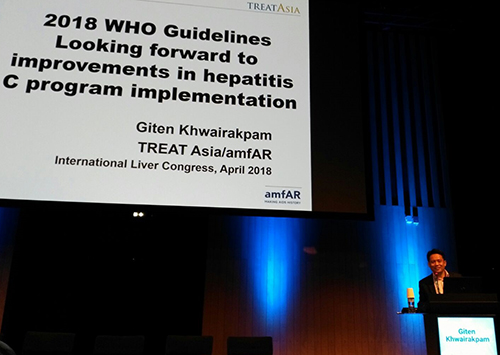According to the World Health Organization (WHO), in 2015, about 257 million people around the world were living with chronic hepatitis B (HBV) infection and 71 million people were living with hepatitis C (HCV) infection; 1.34 million died from viral hepatitis-related causes.1 Most people with viral hepatitis have not yet been diagnosed or treated—despite the fact that highly effective HCV treatments have been on the market since 2014.

“With fewer than 10% of people living with hepatitis C diagnosed in low-income countries, patient groups and community advocates are central to ensuring that more people are offered testing and linked to treatment,” says Giten Khwairakpam, TREAT Asia’s community and policy project manager, who spoke at the 2018 International Liver Congress (ILC) in Paris in April. The ILC is the annual meeting of the European Association for the Study of the Liver (EASL), which regularly brings together more than 10,000 liver experts to discuss the latest research on viral hepatitis and other liver diseases.
With 1.75 million people newly infected with hepatitis C each year, more concerted efforts are urgently needed to implement prevention and treatment programs in resource-limited settings.“Although the ILC is more focused on science and medical advancements, it’s important to keep highlighting the value of community groups and civil society to achieve elimination targets,” says Mr. Khwairakpam. He described how civil society organizations work to build demand for access to HCV screening and treatment during a session titled, “Bringing the revolution in hepatitis C treatment to the excluded millions: Strategies to expand access in France and around the world.” Drugs for Neglected Diseases initiative (DNDi) sponsored the session, which was co-organized by TREAT Asia, Médecins Sans Frontières, Médecins du Monde, AIDES, and Coalition PLUS.
This year’s Congress encompassed themes including alcoholic liver disease, cirrhosis, liver tumors, and transplantation—as well as viral hepatitis and goals to eliminate it through prevention and treatment. Substantial global progress has been made in controlling hepatitis C over the past two years—approximately 3 million people have received effective treatment with direct-acting antiviral medicines. But with 1.75 million people newly infected with hepatitis C each year, more concerted efforts are urgently needed to implement prevention and treatment programs in resource-limited settings. Mr. Khwairakpam also participated in WHO-organized meetings on how to scale-up service delivery models in order to eliminate viral hepatitis as a major public health threat by 2030; and a Coalition PLUS/Unitaid meeting on strengthening HCV screening interventions through peer and community engagement, particularly among key populations.
1World Health Organization: Global Hepatitis Report, 2017